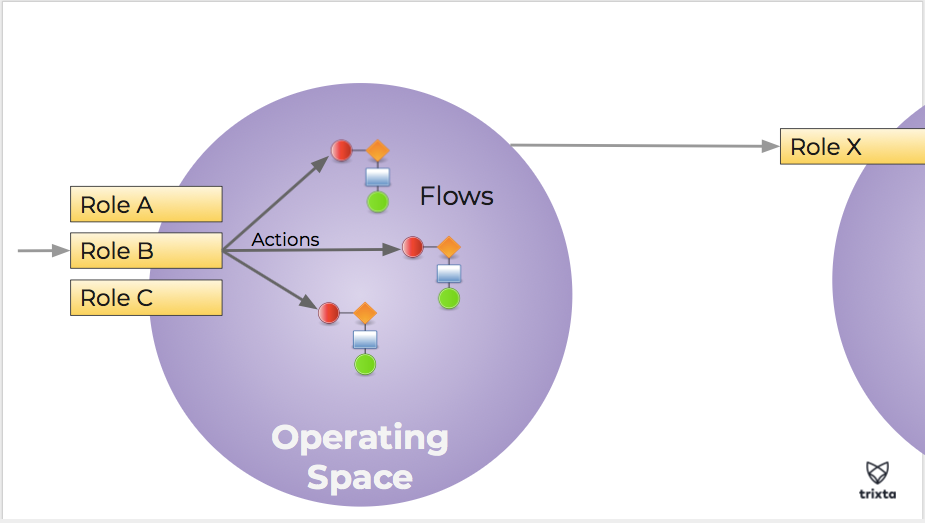Organization Building blocks – Trixta – Medium

The way a school of fish stay together and swim in a coordinated manner to create some of the most complex and highly dynamic systems in order to avoid prey is incredibly complex. But fish really aren’t that smart, so how do they create these complex, dynamic, reactive patterns? Well, they follow three very simple rules:
- Swim away from danger.
- Don’t be further than a certain distance to the fish next to you.
- Don’t be closer than a certain distance to the fish next to you.
Following those three simple rules, the patterns and movements that we call a “school” can be modeled and predicted.
Complexity Theory : draws from research in the natural sciences that examines uncertainty and non-linearity. Complexity theory emphasizes interactions and the accompanying feedback loops that constantly change systems. While it proposes that systems are unpredictable, they are also constrained by order-generating rules.
In Complexity theory, we aim to understand the fundamental elements of a system and try to model the interactions of these elements. That way, as more elements get added, your model can dynamically adjust to provide insight into the emergent system complexity.
Organizations are complex
Over the last 10,000 years, how humans have organized themselves has evolved from family units to massive international conglomerates of hundreds of thousands of employees. This has increased the complexity of dynamic global markets in a significant way.
Organizational forms
Historically humans have naturally used some form of hierarchy providing strong vertical connections in silos. More recently, however, the rise of cheap ubiquitous communication has enabled distributed and decentralized structures.
As the large top-down organizations of the industrial era expanded into multinational conglomerates it became pretty obvious that the next step was for them to become groups of smaller regional companies, allowing them to be more competitive by optimizing for the local environment.
With the ubiquitous adoption of telecommunications and the ability to very easily collaborate and communicate anywhere in the world, we are starting to see a rise in new models of distributed or remote teams and new operating models like Holacracy. The rise of blockchains and decentralized cryptographic ledgers are taking this one step further and challenging the idea of what a company is — favoring loosely coupled communities or organizations held together by a shared purpose.
The rise of the WorldWide Web was driven by the ubiquitous use of the IPX and TCP/IP protocols. They allowed you to host any kind of content on your servers while still ensuring that any other system or browser would be able to find it and retrieve the data that made the request using this protocol.
Creating a protocol like this for business will be critical if we plan to allow the interoperability required to truly empower the horizontal connections in a decentralized organization. (Instead of vertical connections in hierarchies)
Software typically doesn’t model business
While organizational structures are changing, the software that they run on has followed its own increasingly complex path, due to influences like hardware, coding language limitations, or backward compatibility.
Unfortunately, this creates a situation where the influences that have driven technological change are often not optimal for how organizations use the software.
At Trixta, we believe that this is because business software architecture is designed from the code up and not from the business value down. We approach the need to build business software by modeling the business and start with the core elements that can map to any kind of business.
The Trixta ‘protocol’
By structuring our system around mapping the core elements of an organization it allows us to easily model those interactions. The six core elements of Trixta are:
- Spaces (‘operating spaces’) define business functional units oriented around a purpose or context.
- Each space has Roles that have a collection of Actions to define the functions in the space.
- Actions can be used to trigger Flows.
- Flows are a set of connected Steps made of actionable code modules.
- Agents (either people, other systems or other spaces) can fill roles
Spaces, roles, and actions provide the authorization framework to define what agents can actually do. Flows and steps manage what a system does and the specific processes that can be run.

There are three main views in the Trixta interface:
- The Explorer view allows you to visually manage the spaces, roles, and actions — as well as see the relationships between them.
- The Flow Editor provides a visual view of flows, with visual tools to build flows or to interpret flows that are written in code. Analytics of flows and actions are inherently recorded in the system.
- The Reporting pages allow you to build custom dashboards to monitor all aspects of your system.
With these core building blocks, we can map any kind of organizational structure (hierarchical or decentralized). As we build software around these elements we can much more efficiently handle the growing complexity of organizations.
Find out more on www.trixta.com

